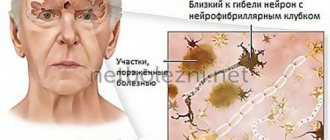ICD-10 is a generally accepted classification of diseases and pathologies of the human body, which allows you to code, systematize and divide them into groups. Among other things, the system contains data on dementias, divided into ICD-10 codes F00 to F03 in the section on mental disorders.
Causes
For a long time, the main cause of vascular dementia was considered to be acute cerebrovascular accidents (hereinafter referred to as ACVA, which means, first of all, stroke). A stroke develops as a result of blockage of an artery by an embolus or thrombus (ischemic stroke) or when an artery ruptures and hemorrhages in the brain (hemorrhagic stroke). In this case, due to lack of nutrition, neurons die.
After a stroke, the likelihood of developing vascular dementia increases significantly. Within 1 year after a stroke, vascular dementia develops in a quarter of patients. The nature of the manifestation of symptoms depends on the area of the brain in which the disorder occurred. The size of the lesion also plays a role. Vascular dementia usually develops when more than 50 ml of brain volume is affected.
However, if circulatory disorders occur in areas important for cognitive functions (visual thalamus, hippocampal region, frontal prefrontal cortex, etc.), then a smaller area of neuronal death can lead to the development of vascular dementia. If other areas are affected, motor disorders and other post-stroke manifestations may occur.
It has now been established that vascular dementia is not always associated with acute disorders. It can occur due to a chronic dyscirculatory process - blockage of small vessels that occurs unnoticed by the patient (the so-called subcortical vascular dementia). It has also become possible to detect these disorders thanks to the spread of digital technology and the spread of neuroimaging methods in medicine.
Neuroimaging (functional MRI, PET, etc.) allows one to observe “silent” areas of vascular lesions in the brain that previously went unnoticed as not leading to an acute lesion (stroke). The development of vascular dementia is possible with a decrease in blood perfusion in the brain.
This occurs against the background of acute or decompensated chronic heart failure, a decrease in circulating blood volume, and a sharp decrease in blood pressure. All these phenomena lead to insufficient blood supply in the peripheral microcirculatory zones of all vascular beds and neuronal death. Based on this, the occurrence of vascular dementia is influenced by two components: stroke and a chronic discirculatory process. When these disorders occur simultaneously, they reinforce each other, leading to more pronounced symptoms.
Let's consider the mechanism of development of vascular dementia.
When the vascular link in various parts of the brain is damaged, neurons do not receive the required amount of oxygen and nutrients, which leads to the death of these cells. Initially, the brain compensates for the violations - they do not appear externally. Over time, the potential is depleted, negative changes begin to affect the state of memory, speech, concentration and speed of thinking. As a result of these cognitive disorders, a person’s behavior changes, and his independence decreases.
All types of vascular dementia account for up to 15% of all cases of dementia in the elderly. There are also often cases of mixed dementia, which combine vascular dementia with Alzheimer's disease. It is believed that as a person ages, the risk of vascular dementia decreases, while the risk of developing Alzheimer's disease increases.
In this regard, the vascular factor is recognized as especially dangerous in the Russian Federation, where life expectancy is still not very high and part of the population simply does not live to the age of onset of another type of dementia. Vascular dementia is also widespread compared to Alzheimer's disease in some Asian countries (Japan, China), and a number of Scandinavian countries (Finland, Sweden).
Risk factors for vascular dementia are:
- high or low blood pressure,
- cerebral atherosclerosis,
- hyperlipidemia,
- cardiac ischemia,
- diabetes,
- arrhythmias,
- hyperhomocysteinemia (now this factor is considered doubtful),
- pathology of heart valves,
- vasculitis.
Smoking, poor diet and a sedentary lifestyle contribute to the risk of developing vascular dementia.
Dementia in the structure of the ICD-10 classifier
The global medical community has adopted a general code for dementia according to ICD 10, which allows us to compare materials, symptoms and the basis of the disease known in the world. In the Russian Federation, the updated tenth system was introduced in 1997. The ICD code allows specialists to quickly understand what disease they are talking about, without voicing the full name. In addition, the ICD is used to designate diseases, information about which cannot be disseminated and kept in the open due to medical confidentiality.
Senile dementia occupies the first part of the section under the letter “F” in ICD 10: “Mental and behavioral disorders.” Dementia ICD 10 code: F00.0 - F00.9, F01.0 - F01.9, F02 - F03.
For convenience, the classifications of dementia are further systematized according to the causes that cause them.
Structure and frequency of dementia cases
| Subtype | Frequency of occurrence, % |
| Alzheimer's | 60-65 |
| Vascular | 12-15 |
| Others | 20-28 |
The exact ICD code corresponding to the subtype of the disease can be established after a complete clinical examination of the patient.
Alzheimer's type dementia
Alzheimer's disease is a type of dementia. The disease is genetic in nature and is characterized by a violation of one or more sections of chromosome 21 of the genome. With a high probability we can say that if there is a history of the dominant gene for senile dementia in close relatives, the disease will also occur. In the case of a recessive gene, transmission to future generations occurs.
The patient's blood microcirculation in the brain and neural connections are disrupted. As a result, there is a gradual decrease in mental activity, memory is impaired and characteristic behavioral characteristics increase.
Dementia code for Alzheimer's disease according to ICD 10 is F00.0, F00.1, F00.2, F00.9.
- F00.0 - for Alzheimer's before the age of 60 years (G30.0+). It begins early, progresses quickly, and is characterized by pronounced disorders of the cerebral cortex.
- F00.1 - Alzheimer's dementia in adulthood after 60-70 years (G30.1+). Progresses slowly, characterized mainly by memory impairment.
- F00.2 - age-related dementia in Alzheimer's, abnormal or combined with other diseases of the subtype (G30.8+).
- F00.9 - other Alzheimer's dementia (G30.9+).
Important! Alzheimer's dementia is incurable. A properly selected course of supportive treatment increases the patient’s life expectancy, reduces the symptoms of the disease and makes life easier for the patient’s loved ones.
Disease due to vascular pathology
The second most common cause of senile dementia is various disorders of the vascular system.
This disease is not genetic; its development requires provoking factors (stroke, heart attack). Characterized by both acute and gradual development, in most cases nonlinear. This means that acute stages alternate with stagnation and stabilization of the condition with constant progression.
ICD 10 code for senile dementia is F01.0, F01.1, F01.2, F01.3, F01.8, F01.9.
- F01.0 is the ICD 10 code for vascular dementia with acute onset. The disease develops rapidly after one or more strokes, blood clots, internal hemorrhages, and cerebral infarction.
- F01.1 - infarction. The disease develops gradually, unnoticed by the patient and others. It is characterized by a decrease in blood circulation to the brain, leading to multiple heart attacks and the development of ischemic necrosis. Affects the cerebral cortex.
- F01.2 - subcortical vascular dementia. The subtype includes increased blood pressure and ischemia in the deep layers of white matter of the right and left hemispheres. Dementia does not affect the cerebral cortex, which is different from the picture of the disease in pathology of the Alzheimer's subtype.
- F01.3 is a code for mixed dementia according to ICD 10. Dementia of mixed origin according to ICD 10 implies the development of the disease against the background of two or more pathologies. In most cases, the second disease develops in parallel with Alzheimer's dementia. The disease affects both the subcortical part of the brain and the cortex.
- F01.8 - other vascular dementia, the ICD code deciphers other possible vascular pathologies, for example, heart attacks, strokes, cerebral hypoxia.
- F01.9 - vascular dementia, unspecified.
The treatment of these subtypes is based on the treatment of the causes that caused them. Control can prevent or slow down regression.
For other diseases
Senile dementia can be caused or develop against the background of other concomitant diseases.
ICD 10 code for senile dementia of various etiologies:
- F02.0 - dementia with Pick's disease. According to the ICD, the form is typical in the initial stage for middle-aged people. Gradually, over 5-10 years, degradation of personality, memory, speech and intellect occurs. The patient is apathetic and in a euphoric state.
- F02.1 - multifocal marasmus with Creutzfeldt-Jakob. According to the ICD, the disease is characterized as rapidly progressive, with changes in the nervous system; death occurs 1.5-2.5 years after diagnosis.
- F02.2 - Huntington's dementia (G10+). Widespread brain degradation occurs. According to statistics, the diagnosis is made to people aged 30-40 years. The disease is subacute, development to death occurs within 10-15 years from the moment of diagnosis.
- F02.3 - age-related dementia in Parkinson's. No special clinical manifestations are observed. Simultaneously with brain degradation, manifestations characteristic of Parkinson's are observed.
- F02.4 - dementia due to HIV. This diagnosis is made to the patient when there are no more diseases that can cause its development.
- F02.8 - dementia with other diagnosed diseases.
- F03 - dementia unspecified according to ICD 10. In the absence of clinical manifestations of signs characteristic of other subtypes, but in the presence of the development of degradation of brain activity, this diagnosis is made until the true causes are clarified.
In the case of the above types of dementia, one pathology affects the other and the patient needs complex treatment for both.
Symptoms
As a rule, “vascular dementia” is diagnosed if cognitive impairment was preceded by a stroke. Quite often, accompanying signs are symptoms of focal brain damage, for example, manifestations of hemiparesis (weakness of the muscles of one side, anisoreflexia, pathological foot signs, etc.). A characteristic symptom is a walking disorder - a slow, shuffling gait and instability (which patients themselves often call dizziness).
As mentioned above, the cause of vascular dementia lies in circulatory disorders in the brain. The potential for disturbances to occur exists in different areas of the brain. Therefore, the external manifestations of vascular type dementia differ significantly in each case. Let's list the most typical ones.
Dementia caused by damage to the midbrain is manifested by mesencephalothalamic syndrome. The first manifestations are confusion and hallucinations. A person becomes apathetic, withdraws into himself, does not care about his appearance, and neglects personal hygiene. His psychophysiological state is usually characterized by increased drowsiness. In some cases there are speech disorders.
In dementia caused by damage to the hippocampus, first of all, there is an impairment in the ability of memory to retain information about current events (long-term memory can be retained).
As a result of a stroke, apathetic-abulsic syndrome is observed in the prefrontal regions of the frontal lobes. The patient behaves inappropriately, there is no criticism of the condition. Inadequacy consists in repeated repetition of one’s own words and actions, or the words and actions of others.
Subcortical lesions lead to disruption, first of all, of daily activities: it is difficult for the patient to concentrate on one subject and maintain one type of activity; problems arise with making plans. There is also a violation of the skills of information analysis (separation of the main from the secondary).
A stable sign of vascular dementia is impaired urination; it is observed in almost all persons suffering from dementia.
Symptoms of vascular dementia are also noticeable in the psycho-emotional sphere. There is a general decrease in mood and self-esteem, emotional instability, depression appear, and self-confidence is lost.
General concept of dementia
The most severe clinical variant of cognitive impairment is dementia. Dementia is understood as a result of an organic disease of the brain, a violation of memory and other higher mental functions, which leads to a limitation of professional abilities and to everyday maladjustment in the absence of disturbances of consciousness. When making a clinical diagnosis, both the qualitative characteristics of the defect of higher mental functions and its severity are taken into account. In dementia, the disorders are complex; the defect is not limited to any one cognitive area, but is revealed by studying several or all higher brain functions. At the same time, existing violations manifest themselves in the restriction of a person in professional or domestic spheres.
ICD-10 diagnostic criteria are used to diagnose dementia. With age, the risk of dementia progressively increases. In the ninth decade, up to 25% of individuals have dementia.
Diagnostic criteria for dementia according to ICD-10:
Memory impairments, which manifest themselves in impaired ability to memorize new material, and in more severe cases, also in difficulty in recalling previously learned information. Violations manifest themselves in both verbal and non-verbal modalities. Mnestic disorders must be objectified using neuropsychological tests.
Impairments in other cognitive functions, manifested by impairments in the ability to judge, think (plan, organize) and process information. These impairments must be confirmed by the results of appropriate neuropsychological tests. A necessary condition for diagnosing dementia is a decrease in cognitive functions compared to a higher initial mnestic-intellectual level.
Impaired cognitive functions are determined against the background of preserved consciousness.
Impaired emotional control or motivation or changes in social behavior - at least one of the following: emotional lability, irritability, apathy, antisocial behavior.
The listed signs must be observed for at least 6 months; with a shorter observation, the diagnosis can be presumptive.
Diagnostics
Dementia of the vascular type is diagnosed in the presence of clinical data, characteristic anamnestic or neuroimaging signs of cerebrovascular disease: previous stroke or cases of subclinical local cerebral ischemia.
It is also important to have a cause-and-effect relationship and a relationship in time between brain damage of vascular etiology and the development of cognitive impairment. The very presence of dyscirculatory disorders according to neuroimaging, as well as the presence of neurological disorders - hemiparesis, speech and swallowing disorders, walking and urination disorders, are mandatory.
It is necessary to differentiate between Alzheimer's disease and vascular dementia.
Once the syndrome of dementia is identified, it should be syndromicly distinguished from depression, moderate or even mild cognitive impairment and delirium. To diagnose depression, various questionnaires and tests should be used (clock drawing test, HADS anxiety and depression scale, Montreal Mental Status Scale, MMSE test, etc.).
The distinction between vascular dementia and dementia due to Alzheimer's disease is often difficult. If in Alzheimer's disease the deterioration can occur slowly and constantly, then in the case of vascular dementia the deterioration occurs suddenly (for example, after stroke) and proceeds in stages.
When the vascular component predominates, the following signs are common: focal neurological symptoms (rigidity, hemiparesis, bradykinesia, bulbar disorders), neuropsychological disorders depending on the location of the cerebral infarction (aphasia, lack of sensory sensitivity, apraxia), gait disturbances (with Parkinson-like or ataxic movements), urinary disorders with urinary incontinence and urgency.
In addition to a thorough neurological examination and targeted laboratory tests, MRI or MSCT is necessary to identify infarcts and white matter lesions.
It must be remembered that quite often the same patient exhibits both signs of vascular dyscirculation and symptoms of Alzheimer's disease. Modern research indicates that the chronic dyscirculatory process is a risk factor for the development of Alzheimer's disease and plays a pathogenetic role in the neurodegenerative process, based on this, the vast majority of cases of dementia are mixed in their pathogenesis - vascular-degenerative.
Description of the disease
Dementia is an acquired dementia that can be reversible or irreversible. There is a generally accepted structuring of ICD-10 depending on the provoking factor.
The course of treatment and rehabilitation of the patient depend on the cause of the disease. The ICD 10 code for dementia in adults does not imply division into stages, it reflects the etiology of the disease.
Causes
The disease comes in two forms based on its origin: genetic or acquired. In the first case, close relatives have a history of senile dementia, Parkinson's or Alzheimer's. In the second case, the disease develops against the background of acute destructive disorders of blood vessels and the brain - heart attack, stroke, addiction, and others.
Provoking factors:
- genetic diseases;
- infectious;
- heart attacks, strokes;
- deficiency of folic acid, vitamins B12, B3;
- alcoholism, drug addiction;
- medication abuse;
- traumatic brain injuries;
- intracerebral tumors, hematomas, abscesses.
Important! When examining a patient, it is necessary to find out the cause of the pathology as soon as possible. Even in the case of an incurable disease, the process can be significantly slowed down with proper treatment.
Stages of development
Like most diseases, dementia can be divided into 3 stages. The patient’s symptoms and behavior depend on what stage of development it is at.
- The mild stage occurs unnoticed by the person and others. It begins with the patient forgetting short-term events, while long-term memory is fine. A person may forget words, form sentences incorrectly, and confuse names. He is apathetic, his mood often changes, and his perception of the interlocutor’s speech is impaired.
- At the middle stage of development, signs manifest themselves and make loved ones worry. Loss of sense of time, disorientation. A person cannot independently perform simple everyday tasks; he can wander mindlessly and ask the same questions. Forgetfulness becomes a frequent symptom, as a result of which the patient may complain, for example, that he is not fed.
- At the final stage, a person is completely dependent on society and cannot perform any actions independently. Speech communication, understanding, and spatial orientation are practically excluded; constant monitoring, care, and supportive rehabilitation are required.
Treatment
Treatment of vascular dementia should be aimed at correcting the pathological factors leading to this condition, as well as directly correcting cognitive functions. It makes no sense to describe all kinds of treatment regimens and give the names of specific drugs with their course and single doses in this article, because each specific case requires an individual approach.
The general principles of therapy for vascular dementia should be the correction of hypertension and cholesterol levels (however, you should not reduce cholesterol levels below 3.5-4 mmol/l due to the risk of a combination of Alzheimer's disease and vascular dementia, and Alzheimer's disease reacts negatively to low cholesterol levels , although, unfortunately, it is not entirely clear why), as well as the use of antiplatelet or anticoagulant therapy.
It is important to carry out a course of treatment with antioxidant (Mexidol, Cytoflavin, etc.), neuroprotective (Actovegin, Ceraxon, Cortexin, etc.), vasoactive (Sermion, Cavinton, etc.) drugs, with individual selection based on availability contraindications in the patient and the clinical picture as a whole, as well as (the author’s opinion), anti-dementia drugs should be used, and the drug of choice should be memantines (Akatinol, Marux, etc.).
An equally important point is non-drug therapy, namely proper patient care and psychological comfort. After all, if you are surrounded by close people, and they treat you with a positive attitude, life becomes a little better.
Forecast
At the present stage of development of medicine, the prognosis for recovery for any type of dementia is unfavorable. Dementia is considered to be an irreversible condition. There is also an unfavorable prognosis for work ability (a patient with dementia is a priori disabled), a relatively unfavorable prognosis for life, but vascular dementia itself is not the cause of the patient’s death.
Death often occurs due to cancer, acute vascular accident, and infectious lesions (especially important among which are diseases of the genitourinary tract due to poor hygiene in patients with dementia).











